Monday, September 6, 2010
Tuna "chutoro" carpaccio with Uni 中トロのカルパッチョの雲丹添え
This is a variation of tuna carpaccio but this is a deluxe version with uni and chutoro 中トロ. I think I made this the second day after we received the goodies from Catalina Offshore products as a very first course of the evening.

Since both tuna sashimi and uni 雲丹 were excellent, I made it very simply. I put splashes of good balsamic vinegar, good olive oil, Kosher salt, freshly cracked black pepper and soy sauce on the bottom of the plate in crisscrossed fashion. I then sliced the chutoro very thinly and place it in one layer on the plate. I sprinkled a halved and thinly sliced red onion and finely chopped garlic chive over the chutoro. In the center, I arrange a circle of thinly sliced cucumber and placed the small mound of uni on top. I garnished with thin nori strips and a dab of real wasabi. I drizzled just a small amount of soy sauce and olive oil over the top. We had this with Napa Cab Angels Landing 2007. This cab is a nice middle-of-the-road Cali cab and went well with this dish but the balsamic vinegar competed a bit with the red wine. For this pairing, I should have omitted the balsamic vinegar. In any case, this is a wonderful dish to start before changing to sake. Oh, the uni was positively excellent.
Saturday, September 4, 2010
Evening at Tako Grill 今夜は鮹グリルで一杯
First of all, this is not meant to be a restaurant review. Unlike many food bloggers, I have never taken pictures at any restaurants or drinking place but I decided to try it with Tako Grill so that we could share our evening at our Izakaya substitute.
Here is today's otoshi お通し; avocado, akami 赤身 in sweet vinegar which contains what appears to be finely chopped transparent (red?) onion (below left). This night, we noticed one of the Niigata 新潟 breweries, "Ichishima" 市島酒造, was featured in the sake menu and as a part of the special, all classes of their sake was available for tasting by the bottle or glass. We decided to try "Jun-Gin" 純米吟醸 in addition to our usual bottle of "Mu". It came in the proper Izakaya way (which did our heart good) with a generous amount of overflow in the "masu" 升 cup underneath (below right).
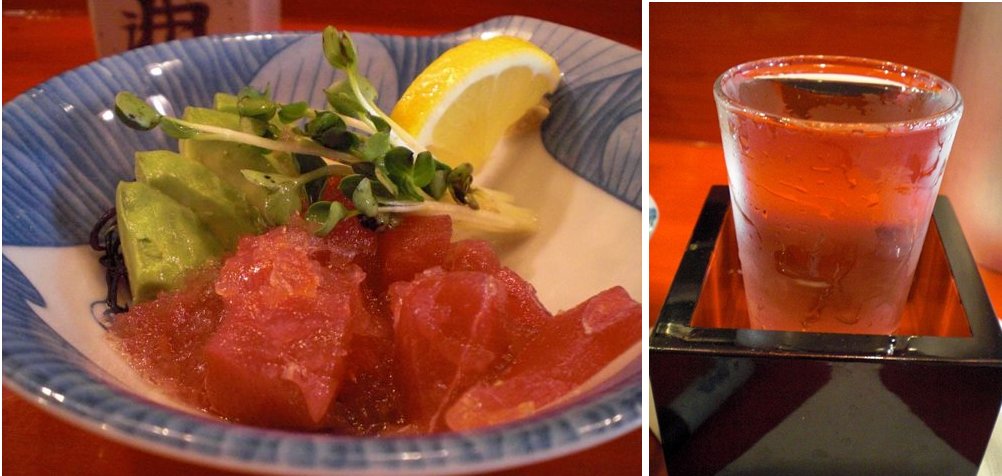
This Ichishima Jun-Gin is rather nice. Very subtle but had a nice clean taste with a slightly assertive finish. Then our waitress suggested we should taste other Ichishima and brought out small cups of "Junmai" 純米 and "Junmai genshu" 純米原酒. We both felt that the junmai lacked character. The genshu definitely has a higher alcohol content, which we could feel, and has more edge to it. Among the three Ichishimas we tried, we liked "Jun-Gin" the best but we still like "Mu" better and, for cost performance, our usual "Mu" definitely wins out. Now, we were fairly sloshed and moving into the sashimis.
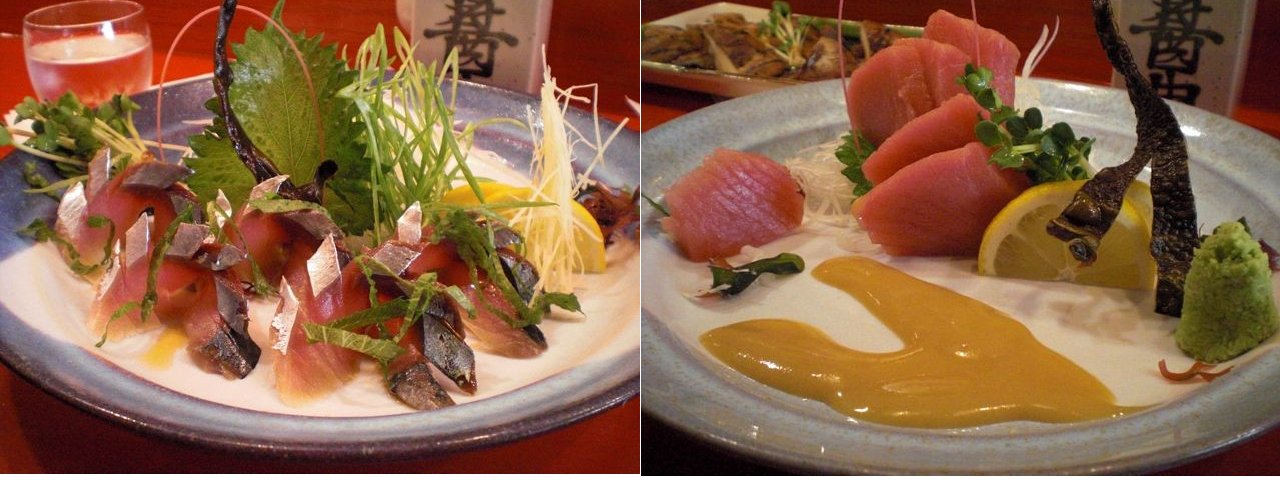
Sekisaba 関サバ (above left) is served already seasoned with (rock?) salt and sesame oil (mist?) and served with plenty of sliced scallion and threads of ginger which go very well with this oily fish. Big eye Tuna toro めばちのとろ was very nice. By the way, daikon tsuma 大根のつま was skillfully hand cut. Even in Japan, many Izakayas serve daikon tsuma prepared by a special cutter such as Benriner turning "head" slicer (actually we have one of these devices which I have not used for some time). Although this does not make any difference in the quality of the food they serve, I like the fact they pay attention to the details and take pride in these minor items. From robatayaki 炉端焼き menu, we ordered grilled shiitake mushroom (barely visible behind the toro sashimi picture above. I forgot to take a picture), Ginko nuts 焼き銀杏 (below left), and shishi-tougarashi ししとう (below right). As usually happens, with shishito produced in the United States, two of the peppers were atomic hot, each of us got one. Part of the fun of the dish is the Russian Roulette aspect of whether the one going into your mouth is a "hot" one.
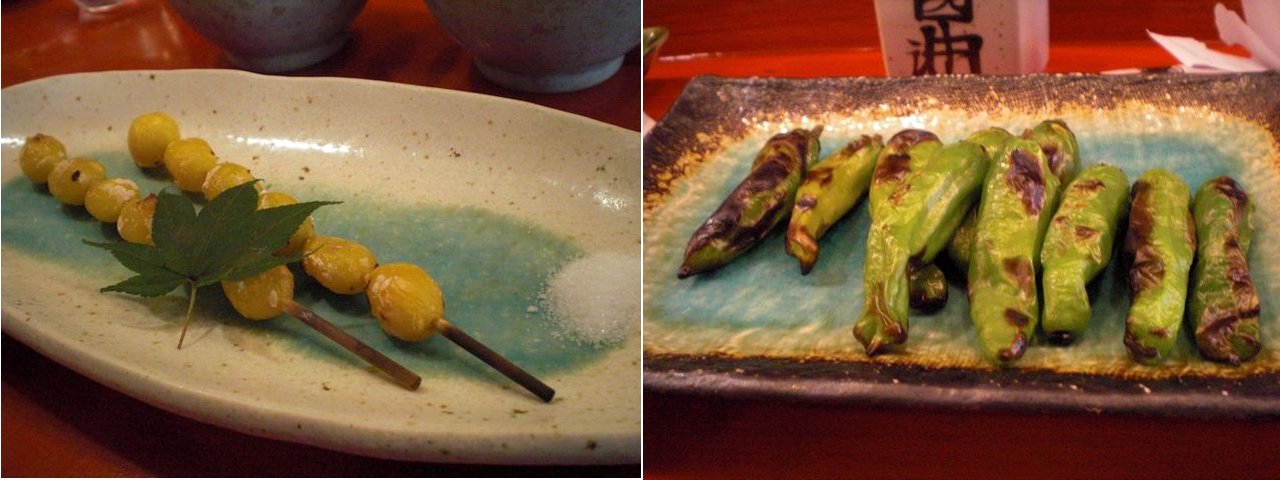
We were winding down here and had a very meaty "Hamachi kama" はまちのかま grilled, served with a large mound of grated daikon 大根おろし, which I like. My wife is usually in charge of taking off all the available meat from the bone and, as usual, she did an excellent job. As a shime 締め, we had few nigiri and two US style rolls (A California roll was made of real lump crab meat, avocado and tobiko roe. A Philly roll was made of smoked salmon, cucumber and cream cheese).
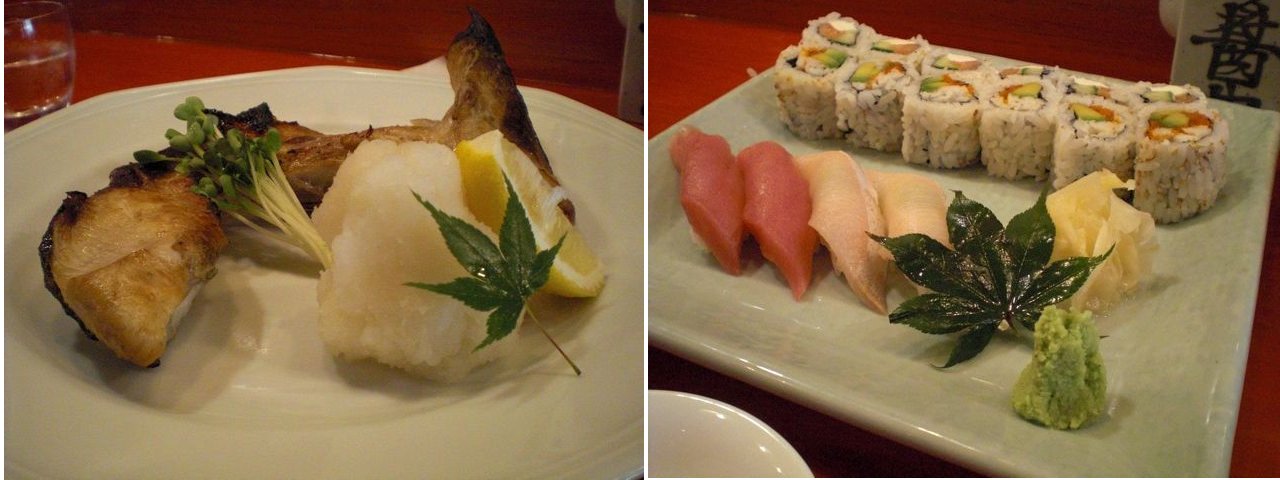
We were stuffed and had more than enough sake at this point. Chef Kudo sent us an ice cream daifuku (Ice cream encased in a mochi skin) for dessert. We do not have thousands of Izakayas to visit but we were doing well here for sure tonight.
Tako has a large sake bar as you enter and the sake menu is extensive. Early on, we tried some of these sakes but we settled on Yaegaki "Mu" 八重垣『無』as our "usual". It is also our house sake. It became "the usual" since it is reasonably priced especially for "junmai daiginjou" 純米大吟醸 and is nicely fruity with a clean crispy finish, although it may not be as complex as more expensive sakes.
Here is today's otoshi お通し; avocado, akami 赤身 in sweet vinegar which contains what appears to be finely chopped transparent (red?) onion (below left). This night, we noticed one of the Niigata 新潟 breweries, "Ichishima" 市島酒造, was featured in the sake menu and as a part of the special, all classes of their sake was available for tasting by the bottle or glass. We decided to try "Jun-Gin" 純米吟醸 in addition to our usual bottle of "Mu". It came in the proper Izakaya way (which did our heart good) with a generous amount of overflow in the "masu" 升 cup underneath (below right).
Thursday, September 2, 2010
Tuna "chiai" natto with egg yolk 血合いの漬け卵黄いり納豆
This is a variation of "Tuna and natto" or マグロ納豆. After I removed chiai 血合い from the tuna block we got, instead of throwing it out (I never tasted chiai of tuna in Japan but I never got to clean the tuna block, either), I usually make this dish or a type of soup with grilled scallion. Chiai is very dark red and has a very gamy strong taste and is certainly the least desirable portion of tuna.
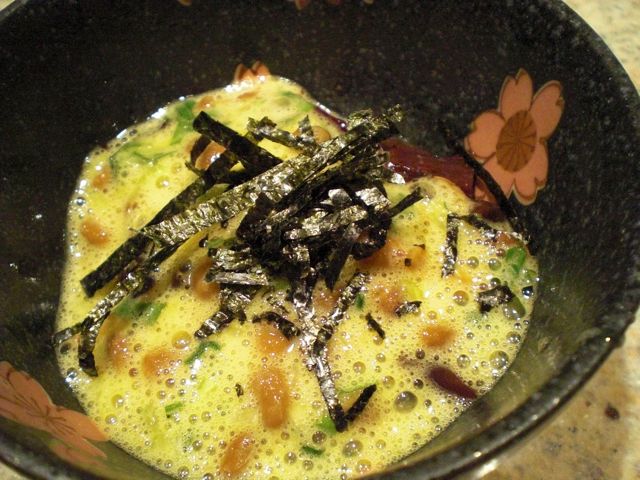
After removing the chiai, I cut it into small chunks and marinaded it overnight in the refrigerator in a mixture of concentrated noodle dipping sauce (2x concentrated) with 1/3 the amount of sake (or a mixture of mirin, sake, and soy sauce 1:1:2 ratio). After soaking overnight or for 24 hours, I drained the marinade and placed the cubes of marinated chiai in a bowl. I prepared one small package of natto (for two servings) in my usual way but this time I added an egg yolk (of course, I used a pasteurized shell egg especially since we are in the middle of a big egg recalls due to Salmonella contamination). The addition of the egg yolk gives a very nice and much richer taste and texture. It is still "slimy" or becomes even slimier. (Great dish for Japanese in August)
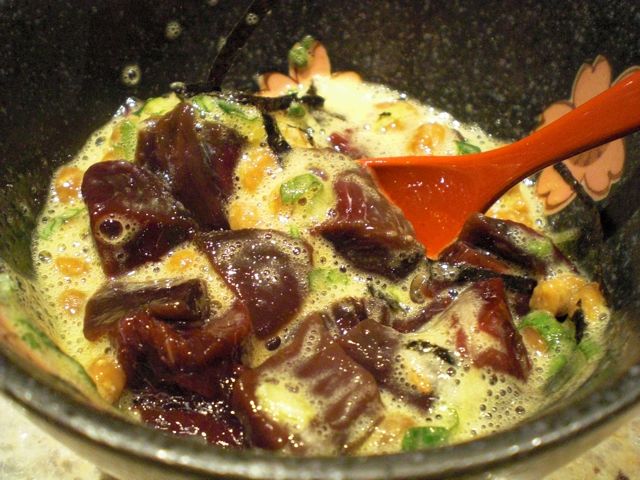
This is usually not for Westerners but my wife likes it (it did take a long time before she could eat let alone enjoy natto). This dish needs cold sake to wash it down.
Tuesday, August 31, 2010
Roasted pork tenderloin with rosemary ポークテンダーロインのオーブン焼き
We cook this very often and we use the leftovers for sandwiches and other dishes. We cook this in several different ways depending on the situation, although the initial preparation is the same. I use packaged pork tenderloin (usually two in the package) and season it with rosemary, salt and black pepper. We cook this one of three ways: 1) In a low-temperature oven (350F) for 1 hour with other vegetables (sweet potato, onion, garlic-clove separated but with skin still on, carrot etc. coated with olive oil, 2) Seared first in a frying pan and finished in a 400F oven, 3) Using a Weber grill. The end products are slightly different but all are good in their own way.
Preparation: After removing the silver skin and the ends (tail and head) of the tenderloins (I use these cut off portions for other pork dishes), you will have two nice cylinders with an even diameter throughout the length of the loins. I finely chop fresh rosemary (2 tbs) and mix it with olive oil (4 tbs) and coat the surface of the meat generously and season it with salt and freshly cracked black pepper. This time I used the method #2 above. I added olive oil (1 tbs) to a frying pan on a medium high flame and seared the surface all round by turning 90 degree once one side is nicely browned. Then I put it in a 400F preheated oven for about 10 minutes or until internal temperature reads 145F at the center of the loin. I remove the meat and keep it warm on a plate under a tent of aluminum foil.
Sauce: I made a red wine reduction with a sprig of rosemary in it ahead of time and used it on the pork. I made this reduction since I had leftover red wine (called "Cheap Red Wine"). I reduced it to 1/4 of the original volume with a sprig of fresh rosemary in it.
Preparation: After removing the silver skin and the ends (tail and head) of the tenderloins (I use these cut off portions for other pork dishes), you will have two nice cylinders with an even diameter throughout the length of the loins. I finely chop fresh rosemary (2 tbs) and mix it with olive oil (4 tbs) and coat the surface of the meat generously and season it with salt and freshly cracked black pepper. This time I used the method #2 above. I added olive oil (1 tbs) to a frying pan on a medium high flame and seared the surface all round by turning 90 degree once one side is nicely browned. Then I put it in a 400F preheated oven for about 10 minutes or until internal temperature reads 145F at the center of the loin. I remove the meat and keep it warm on a plate under a tent of aluminum foil.
Sauce: I made a red wine reduction with a sprig of rosemary in it ahead of time and used it on the pork. I made this reduction since I had leftover red wine (called "Cheap Red Wine"). I reduced it to 1/4 of the original volume with a sprig of fresh rosemary in it.
I removed the excess oil from the frying pan in which the pork was cooked using a paper towel On a medium flame, I deglazed the brown bits from the bottom of the pan ("fond") with a 1-2 tsp of red wine vinegar and let cook down until it was almost dry. Then I added the rosemary flavored red wine reduction (4 tbs). I also added any juices that may have accumulated on the plate on which the pork was resting. I seasoned the sauce with a bit of sugar, salt and pepper. I finished the sauce with several pats of butter. Another sauce that we use, especially if the meat is cooked in one of the other two ways and there is no "fond" to deglaze, is a simply reduced balsamic vinegar.
Since I had leftover fennel (1/3 bulb), red onion (1/2 medium), and sweet potato (1/3, medium), I just cut them up in equal sized strips and sauteed them in olive oil with salt and pepper and placed the frying pan in the same oven to finish as an accompaniment. The "presentation" of this dish, as shown in the picture, could stand some improvement but it did taste good.
Monday, August 30, 2010
Chicken patty with perilla つくねの大葉焼き
This is a variation of "Tsukune" つくね or Japanese style chicken patty. You could make this with any variation of seasonings. For this one, besides ground chicken, I added chopped shallot, a small amount of miso, grated ginger, grated garlic, soy sauce and mirin. As a binder, I also added potato starch and small amount of beaten egg. Unfortunately, I did not measure anything but you could always cook a small portion of the meat mixture and taste to adjust the seasonings. I make a flat oval about the size of perilla leaves and attach perilla leaves on both side. On medium-low heat, I fried it in a small amount of olive oil, for several minutes on both sides or until done. You could make a sauce with mirin and soy sauce towards the end of cooking to make the sauce thicken and cling to the patties but I just served it with tonkatsu sauce and Japanese hot mustard.

The perilla becomes crispy and adds its distinctive flavor. Miso make nice nutty and salty taste and it did not need any sauce. Again a simple quick dish but excellent with sake, nonetheless.
Saturday, August 28, 2010
Making tekkamaki and uni sushi at home 鉄火巻きと雲丹の軍艦巻き
Since we received the shipment of tuna and uni from Catalina, we are "pushing" these items on our menu--lunch and dinner. We gave some serious thought to breakfast but decided to draw the line somewhere. I made this as lunch over the weekend.

I put enough uni on the gunkan-maki base to cover the rice (generously).
At home, I usually make sushi rolls 巻き寿司 or scattered sushi "chirashi" ちらし寿司 but not "nigiri" 握り寿司 which requires the skill that I do not have. Among the sushi rolls, one is called futomaki 太巻き. I actually make a deluxe (?) version which our sushi chef, Hajime, at the long-defunct Japanese restaurant, Mikado, showed me how to make many years ago. This deluxe version uses two nori sheets with both uramaki 裏巻き (the rice layer facing outside) and omotemaki 表巻き (the rice layer inside and the nori outside) combined into one roll. I am sure I will post it sometime in the future. Another roll I make often is California roll since it is uramaki, it is easier to make (it will not come apart easily like a regular hosomaki 細巻き and the ingredients are readily available at any time in the U.S.- avocado and crab meat.
This time I made a classic Tekka roll 鉄火巻き using an akami 赤身 portion of the tuna and "Uni no gunkan-maki" 雲丹の軍艦巻き.

First, I make sushi rice. Since my wife (and myself) like a good vinegar flavor, I add as much sushi vinegar (from the bottle, but one which contains real rice vinegar such as Mizkan ミツカン brand ) as the rice can absorb.
Next, I make the base for the Uni sushi called "Gunkan-maki" 軍艦巻き, "gunkan" means a miitary ship since it resembles the hull of a naval vessel (see the flotilla in the lower left image). I just make a small oval shaped rice ball and then wrap a nori sheet (cut 1/2 along the long axis to make a half-width nori sheet and then cut long strips with 1/3 of the width of the half sheet). I use a rice kernel to secure the end of the nori strip to make the nori-rice container as in the lower left image (another technique I learned from Hajime the sushi chef). The lower right is a tray of uni from Catalina.
To make the tuna tekka maki, I cut a long rectangle of akami of tuna for tekka maki. I put a small amount of real wasabi on a small plate.

I cut a full sheet of nori 海苔 in half and place in on the bamboo sushi mat or makisu 巻き簾 (lower left) and spread the sushi rice in a thin layer and smear wasabi along the mid-line. I make sure to leave a 1/2 inch of nori at the far end uncovered, otherwise, the roll will not close or stay closed. To prevent the rice from sticking to my hands, I use cold water with a dash of vinegar in it to moisten my hand. I shake off or wipe off excess moisture from my hands using a tea towel just before touching the rice every time. This keeps my hands cold and prevents the rice from sticking.
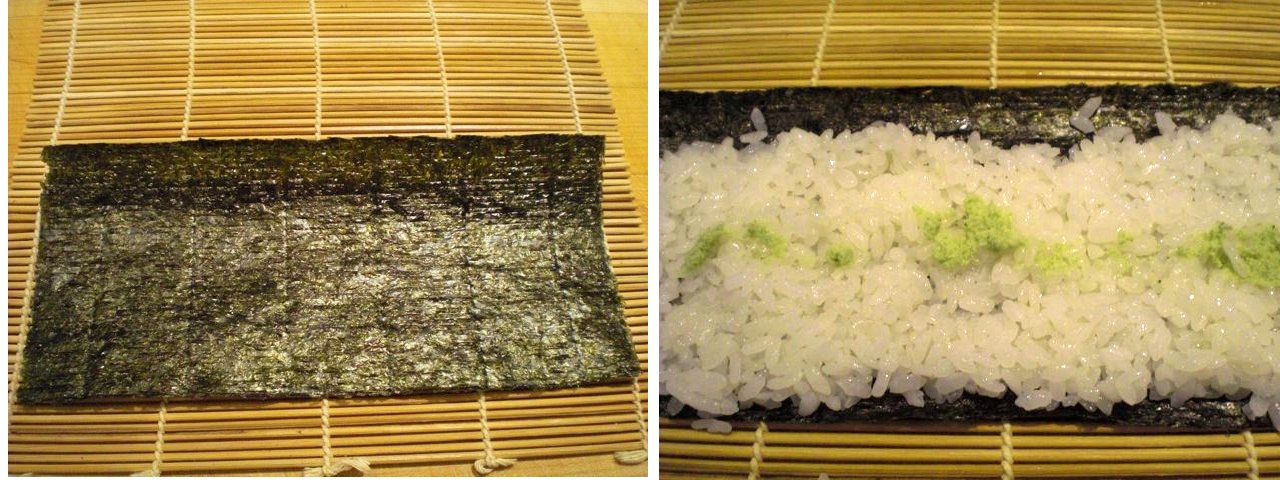

 This was lunch but we had a one small glass of cold sake. (The taste of vinegared rice demands the accompanying taste of sake). It may not look as pretty as the ones prepared by a pro but this tasted very good. Certainly 100% better than any box of sushi bought at the grocer store.
This was lunch but we had a one small glass of cold sake. (The taste of vinegared rice demands the accompanying taste of sake). It may not look as pretty as the ones prepared by a pro but this tasted very good. Certainly 100% better than any box of sushi bought at the grocer store.
I place the rectangles of akami on top of the stripe of smeared wasabi. Since I took these pictures myself, I cannot show how I made the roll more precisely using pictures. Here goes a verbal description: with the edge of nori covered in rice close to me, while holding the tuna with my index fingers in the middle of the roll, I aim the rice covered edge to meet the far edge of the rice layer. I then pull back slightly so the two rice edges make good contact. Then I roll forward again so the nori tab covers the rice seam. (This step is what assures that the pieces of the roll hold together after they are cut). Once the seal has been made, I squeeze the bamboo mat to form the roll.
Anyway here is the end result. The rice should not come out at the bottom seam and the nori should wrap all around. After making two rolls I used a thin bladed sharp knife, put the rolls next to each other and cut both rolls simultaneously. (I do not have a Japanese yanagi-ba 柳刃 so I use a long "Swedish" fillet knife from Global - for slicing smoke salmon, I suppose - but works very well). I dip the blade into the water vinegar mixture and shake off the excess water before slicing the rolls (all this is to prevent the rice from sticking to the blade of the knife). Imitating a sushi chef, I cut the rolls in half first and then cut the each half into thirds.
Thursday, August 26, 2010
Sweet shrimp ceviche Japanese style with yuzu and wasabi 甘エビの和風サビーチェ
Subscribe to:
Comments (Atom)


